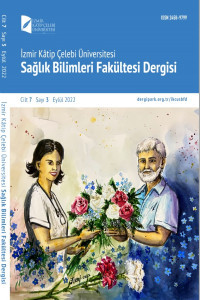COVID-19 Pandemisi Nedeniyle Evde Kalış Döneminin Hemiparetik Serebral Palsili Çocuklarda Fonksiyonel Kapasite ve Denge Üzerine Etkisi
Serebral palsi, COVID-19, denge, kaba motor fonksiyon.
The Effect of Staying at Home Due to the COVID-19 Pandemic on Functional Capacity and Balance in Children with Hemiparetic Cerebral Palsy
Cerebral palsy, COVID-19, balance, gross motor function.,
___
- World Health Organization. Novel Coronavirus (2019-nCoV) Situation Report–1.2020. Available from: https://www.who.int/docs/defaultsource/coronaviruse/situation-reports/.
- T.C. Sağlık Bakanlığı. COVID-19 (SARS-CoV-2 Enfeksiyonu) Rehberi. 2020. Available from : https://covid19bilgi.saglik.gov.tr/depo/rehberler/COVID-19_Rehberi.pdf.
- World Health Organization.Coronavirus disease 2019 (COVID-19) Situation Report –51. 2020. Available from: https://www.who.int/docs/default-source/coronaviruse/situation-reports.
- Sucuoğlu H. Serebral palsili hastaların demografik ve klinik özellikleri. İstanbul Med J. 2018; 19 (3):219-224.
- Erdem ST, Ünlü AE, Çevikol A, Sultanoğlu H. Serebral palsili demografik ve klinik özellikleri. Ege Journal of Medicine. 2019; 58 (3):265-273.
- Miller F, Bolton M, Capone C, Chambers, H. Etiology, epidemiology, pathology and diagnosis, in: Hardcover, Cerebral Palsy. New York Springer Science. 2005; 27:31.
- Matthews DJ, Balaban B. Management of spasticity in children with CP. Acta Orthopaedica et Traumatologica Turcica. 2009; 43: 81-86.
- Donker SF, Ledebt A, Roerdink M. Savelsbergh GJ. Children with cerebral palsy exhibit greater and more regular postural sway than typically developing children. Experimental Brain Research. 2008; 184(3):363-370.
- Gunel MK, Kara OK, Ozal C, Turker D. Virtual reality in rehabilitation of children with cerebral palsy. Cerebral Palsy-Challenges for the Future. 2014; 273-301.
- Günel MK. Serebral Palsi’de multidisipliner yaklaşım. Pelikan Kitapevi. 2015.
- Heyrman L, Molenaers G, Desloovere K, Verheyden G. A clinical tool to measure trunk control in children with cerebral palsy: the Trunk Control Measurement Scale. Research in developmental disabilities. 2011: 32 (6): 2624-2635.
- Chrysagis N, Skordilis EK, Koutsouki D. Validity and clinical utility of functional assessments in children with cerebral palsy. Archives of Physical Medicine and Rehabilitation. 2014; 95 (2): 369-374.
- Williams EN, Carroll SG, Reddihough DS, Phillips BA, Galea MP. Investigation of the timed 'up & go' test in children. Developmental medicine and child neurology. 2005; 47 (8): 518-524.
- Liao HF, Mao PJ, Hwang AW. Test-retest reliability of balance tests in children with cerebral palsy. Dev Med Child Neurol. 2001;43(3):180–6.
- Yazıcı M.Effects of robotic rehabilitation on walking and balance in pediatric patients with hemiparetic cerebral palsy. Gait & posture. 2019; 397-402.
- Hanifi B, Gürsoy S. Spastik serebral palsili hastalarda pasif germe egzersizlerinin 10 metre yürüme zamanına etkisi. Cumhuriyet Üniversitesi Sağlık Bilimleri Enstitüsü Dergisi. 2019; 4(3).
- Kurt A, Erden, M. Koronavirüs Hastalığı 2019 sürecinde özel gereksinimli bireyler. Milli Eğitim Dergisi. 2019; 49(1): 1105-1119.
- Kaya P, Yılmaz ÖT. Serebral Palsi’de interaktif video oyunlarının denge ve performans üzerine akut etkisi. Ergoterapi ve Rehabilitasyon Dergisi. 2018; 6(2): 95-104.
- Novak I, Morgan C, Fahey M, Finch-Edmondson M. Systematic review of interventions for preventing and treating children with cerebral palsy. Current neurology and Neuroscience Reports. 2020; 20(2): 1-21.
- ISSN: 2458-9799
- Yayın Aralığı: Yılda 3 Sayı
- Başlangıç: 2016
- Yayıncı: İzmir Katip Çelebi Üniversitesi
65 Yaş ve Üzeri Bireylerin Bağışıklama Durumlarının Belirlenmesi: Aile Sağlığı Merkezi Örneği
Feyza DERELİ, Gülçin UYANIK, Jülide Gülizar YILDIRIM, Gamze AĞARTIOĞLU KUNDAKÇI, Medine YILMAZ
Egzersiz ve Bağırsak Mikrobiyotası Arasındaki İlişki
Menşure Nur ÇELİK, Feride AYYILDIZ
Beslenme ve Yaşam Tarzının Yaşa Bağlı Makula Dejenerasyonuna Etkisi
Derya AZİM REZAEİ, Güzin KAYA AYTUTULDU, Burcu ERSÖZ HÜSEYİNSİNOĞLU
Arzu GÜNGÖR TOLASA, Yasemin TOKEM
COVID-19 Salgını; Acil Müdahale Gerektiren Kardiyopulmoner Durumlar ve Hemşirelik Bakımı
Elanur YILMAZ KARABULUTLU, Yasemin ÇIRACI YAŞAR
Adölesanlarda COVID-19 Korkusunun Sağlığı Geliştirme Davranışlarına Etkisi
COVID-19 Salgını Karşısında Sağlık Okuryazarlığının Katkısı ve Önemi
Jinekolojik Cerrahide Ameliyat Sonrası Erken İyileşme: Sistematik Derleme
Eda POLAT, Merve TUNCER, Özlem İBRAHİMOĞLU
Rekabetçi ve Rekreasyonel Motokros Sporcularında Spora Bağlı Yaralanmaların İncelenmesi
Bahar AYBERK, Berna KILIÇ, Eren TİMURTAŞ, İlkşan DEMİRBÜKEN, Mine Gülden POLAT
